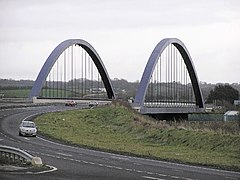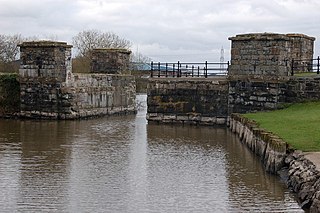Toome
Village in County Antrim, Northern Ireland From Wikipedia, the free encyclopedia
Village in County Antrim, Northern Ireland From Wikipedia, the free encyclopedia
Toome or Toomebridge (from Irish Tuaim, meaning 'tumulus')[2] is a small village and townland on the northwest corner of Lough Neagh in County Antrim, Northern Ireland. It lies in the civil parish of Duneane in the former barony of Toome Upper,[2] and is in the Antrim and Newtownabbey Borough Council area. It had a population of 781 in the 2011 census.[3]
| Toome | |
|---|---|
 The bridge over the River Bann at Toome (built 2004) | |
Location within Northern Ireland | |
| Population | 781 (2011 census) |
| Irish grid reference | H9990 |
| • Belfast | 24 |
| District | |
| County | |
| Country | Northern Ireland |
| Sovereign state | United Kingdom |
| Post town | ANTRIM |
| Postcode district | BT41 |
| Dialling code | 028 |
| UK Parliament | |
| NI Assembly | |
In the 5th and/or 6th centuries, there was a woman in the parish of Dún dá Én (Duneane) known as Ercnat ingen Dáire. In 800 she was remembered as a saint but her cult was forgotten.[4]
Roddy McCorley, a Presbyterian radical, was a local of the parish of Duneane. He fought as a United Irishman in the Rebellion of 1798 against British rule in Ireland but was captured. He was hanged on 28 February 1800 "near the bridge of Toome", which had been partially destroyed by rebels in 1798 to prevent the arrival of reinforcements from west of the River Bann. His body was then dissected by the British and buried under the road that went from Belfast to Derry. In 1852, when the road was being reconstructed, a nephew had McCorley's body exhumed and given a proper burial in an unmarked grave in Duneane. A memorial in honour of McCorley now stands in Toome as you enter the village from County Londonderry. His story became the subject of a popular song written in 1898 by Ethna Carbery.
The largest industry in Toome is eel fishing, supplying the European market. The eel fisheries have been commemorated in a number of poems by Seamus Heaney.
Within the last century, mining for diatomite has developed as extensive deposits are found in the Toome area. This mineral was used as an absorbent for gelignite and for toothpaste.
The local Gaelic Athletic Association club in the area is Erins Own, Cargin.
Some of the most thrilling[original research?] motor boat (hydroplane) racing ever seen in Ireland took place at Toombridge on the River Bann in 1930. Hydroplanes from Ulster, the Irish Free State and England took part in the 'Bann 100'. The main trophies was The Belfast Newsletter Challenge trophy. Hydroplanes reached speeds of 34.77 mph.[5]

Toome had long been a bottleneck to traffic on the main Belfast to Derry road route. Construction of a bypass began in May 2002 and was completed in March 2004, shortening journey times and relieving congestion in the village.[citation needed]
Toome Bridge railway station was opened on 10 November 1856, shut for passenger traffic on 28 August 1950 and shut altogether on 1 October 1959.[6]
In the 2011 census, Toome had a population of 781 (263 households);[3] 91% were from a Catholic background and 6.3% were from a Protestant background.
Toome is classified as a small village or hamlet by the NI Statistics and Research Agency (i.e. with population between 500 and 1,000). On census day (29 April 2001) there were 722 people living in Toome. Of these:
In the 1911 census, Toome had a population of 194. Of these:
Seamless Wikipedia browsing. On steroids.
Every time you click a link to Wikipedia, Wiktionary or Wikiquote in your browser's search results, it will show the modern Wikiwand interface.
Wikiwand extension is a five stars, simple, with minimum permission required to keep your browsing private, safe and transparent.